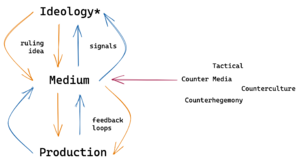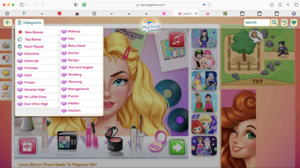User:Bnstlv/methods: Difference between revisions
| Line 74: | Line 74: | ||
Annotating games: | Annotating games: | ||
- One-sentence synopsis | |||
- Role (identification) | |||
- Social reproduction (what real-world values are reproduced in the game you are playing?) | |||
- How are you situated in the hierarchy of the game? | |||
- What change in status is promised? (you may move up a level but you stay in the same position.) | |||
- What are you being trained for?: | |||
- What fantasies are lived out or explored? | |||
Revision as of 21:36, 25 January 2023
Methods 01 Seeds were planted
Pad: Le Guin, acacia seeds and un-naming
Steve // intro+work
- Le Guin, acacia seeds and un-naming
- Ursula K. Le Guin on Wikipedia
- Hainish Cycle
- The Left Hand of Darkness
- Earthsea
- The Carrier Bag Theory of Fiction
Methods 02 What-How-Why
transclusion-cards - Stephen and I worked on making a card about the process of "transcluding" content.
Reading list
Methods 03 Deck of Cards
Pad: Making Deck of Card about Gardening
Methods 05 A textile, a Framework
Jan 18, The Ruling Ideas
Pad: The Ruling Class and the Ruling Ideas
Today's session was very interesting. In the first half of the day, we observed and discussed an illustration by Chad McCail. The three panels depict how robots run zombies for wealthy parasites and according to Karl Marx. At first, the visualisation reminded me of 'The Garden of Earthly Delights', a triptych by Hieronymus Bosch. The longer I look, the more things I see in common between the two pieces, from the illustrative approach of each author to the vivid imagery, to the complexity of symbolic meaning.
Later, we read and discussed Chapter 1, p.9-12, Pad: The Ruling Class and the Ruling Ideas by Marx and Engels. We ended the day with another discussion about weddings as rituals, what they share in terms of characteristics, and how all those relate to games.
Jan 25, Ideology in everyday
Pad: Outcome: reading ideology in popular games
Morning | Superstructure <-> Base Alternative
We talked about Marx's theory of the Base-Superstructure model. We made our version of it on Monday and today we expanded it a little more by adding the counterhegemony component. The Ideology-Medium-Production structure does not necessarily have to be presented in a hierarchical way or vertically.
In this case, they are seen as an example of a timeless process propelled by each end.
Imagine it as two circles connected to each other, like an 8 or an infinity sign (∞).
The connection is made by Medium. It plays the role of the processing tool (ground) that signals the Ideology that has been produced. As to Production, it converts the ruling idea into various executable forms, such as art, science, media, religion, politics, culture and so on.
Basically, Medium shapes and maintains this version of Marx's theory.
Afternoon | Playing and annotating games
In the second half of the day, Steve suggested playing games and annotating them following this method:
Annotating games: - One-sentence synopsis - Role (identification) - Social reproduction (what real-world values are reproduced in the game you are playing?) - How are you situated in the hierarchy of the game? - What change in status is promised? (you may move up a level but you stay in the same position.) - What are you being trained for?: - What fantasies are lived out or explored?



